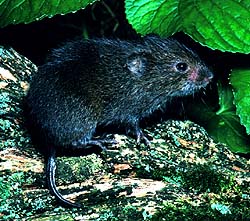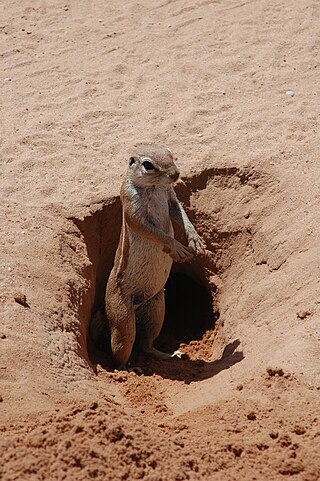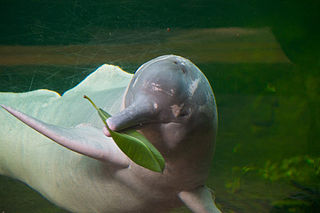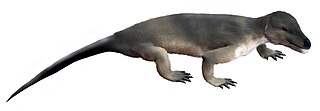
A chordate is a deuterostomic animal belonging to the phylum Chordata. All chordates possess, at some point during their larval or adult stages, five distinctive physical characteristics (synapomorphies) that distinguish them from other taxa. These five synapomorphies are a notochord, a hollow dorsal nerve cord, an endostyle or thyroid, pharyngeal slits, and a post-anal tail. The name "chordate" comes from the first of these synapomorphies, the notochord, which plays a significant role in chordate body plan structuring and movements. Chordates are also bilaterally symmetric, have a coelom, possess a closed circulatory system, and exhibit metameric segmentation.

Invertebrates is an umbrella term describing animals that neither develop nor retain a vertebral column, which evolved from the notochord. It is a paraphyletic grouping including all animals excluding the chordate subphylum Vertebrata, i.e. vertebrates. Well-known phyla of invertebrates include arthropods, mollusks, annelids, echinoderms, flatworms, cnidarians and sponges.

Jerboas are hopping desert rodents found throughout North Africa and Asia, and are members of the family Dipodidae. They tend to live in hot deserts.

Diprotodontia is the largest extant order of marsupials, with about 155 species, including the kangaroos, wallabies, possums, koala, wombats, and many others. Extinct diprotodonts include the hippopotamus-sized Diprotodon, and Thylacoleo, the so-called "marsupial lion".

The Cricetidae are a family of rodents in the large and complex superfamily Muroidea. It includes true hamsters, voles, lemmings, muskrats, and New World rats and mice. At over 870 species, it is the either the largest or second-largest family of mammals, and has members throughout the Americas, Europe and Asia.
Spatial ecology studies the ultimate distributional or spatial unit occupied by a species. In a particular habitat shared by several species, each of the species is usually confined to its own microhabitat or spatial niche because two species in the same general territory cannot usually occupy the same ecological niche for any significant length of time.

The common wombat, also known as the coarse-haired wombat or bare-nosed wombat, is a marsupial, one of three extant species of wombats and the only one in the genus Vombatus. The common wombat grows to an average of 98 cm (39 in) long and a weight of 26 kg (57 lb).

The great gerbil is a large rodent found throughout much of Central Asia.

A fossorial animal is one that is adapted to digging and which lives primarily underground. Examples of fossorial vertebrates are badgers, naked mole-rats, meerkats, armadillos, wombats, and mole salamanders. Among invertebrates, many molluscs, insects, and arachnids are fossorial.

Island gigantism, or insular gigantism, is a biological phenomenon in which the size of an animal species isolated on an island increases dramatically in comparison to its mainland relatives. Island gigantism is one aspect of the more general "island effect" or "Foster's rule", which posits that when mainland animals colonize islands, small species tend to evolve larger bodies, and large species tend to evolve smaller bodies. This is itself one aspect of the more general phenomenon of island syndrome which describes the differences in morphology, ecology, physiology and behaviour of insular species compared to their continental counterparts. Following the arrival of humans and associated introduced predators, many giant as well as other island endemics have become extinct. A similar size increase, as well as increased woodiness, has been observed in some insular plants such as the Mapou tree in Mauritius which is also known as the "Mauritian baobab" although it is member of the grape family (Vitaceae).
Spatial epidemiology is a subfield of epidemiology focused on the study of the spatial distribution of health outcomes; it is closely related to health geography.

Aquatic and semiaquatic mammals are a diverse group of mammals that dwell partly or entirely in bodies of water. They include the various marine mammals who dwell in oceans, as well as various freshwater species, such as the European otter. They are not a taxon and are not unified by any distinct biological grouping, but rather their dependence on and integral relation to aquatic ecosystems. The level of dependence on aquatic life varies greatly among species. Among freshwater taxa, the Amazonian manatee and river dolphins are completely aquatic and fully dependent on aquatic ecosystems. Semiaquatic freshwater taxa include the Baikal seal, which feeds underwater but rests, molts, and breeds on land; and the capybara and hippopotamus which are able to venture in and out of water in search of food.

Species distribution, or speciesdispersion, is the manner in which a biological taxon is spatially arranged. The geographic limits of a particular taxon's distribution is its range, often represented as shaded areas on a map. Patterns of distribution change depending on the scale at which they are viewed, from the arrangement of individuals within a small family unit, to patterns within a population, or the distribution of the entire species as a whole (range). Species distribution is not to be confused with dispersal, which is the movement of individuals away from their region of origin or from a population center of high density.

Many scientists have found the evolution of the eye attractive to study because the eye distinctively exemplifies an analogous organ found in many animal forms. Simple light detection is found in bacteria, single-celled organisms, plants and animals. Complex, image-forming eyes have evolved independently several times.
Spatial descriptive statistics is the intersection of spatial statistics and descriptive statistics; these methods are used for a variety of purposes in geography, particularly in quantitative data analyses involving Geographic Information Systems (GIS).

The evolution of mammals has passed through many stages since the first appearance of their synapsid ancestors in the Pennsylvanian sub-period of the late Carboniferous period. By the mid-Triassic, there were many synapsid species that looked like mammals. The lineage leading to today's mammals split up in the Jurassic; synapsids from this period include Dryolestes, more closely related to extant placentals and marsupials than to monotremes, as well as Ambondro, more closely related to monotremes. Later on, the eutherian and metatherian lineages separated; the metatherians are the animals more closely related to the marsupials, while the eutherians are those more closely related to the placentals. Since Juramaia, the earliest known eutherian, lived 160 million years ago in the Jurassic, this divergence must have occurred in the same period.

Rodents are mammals of the order Rodentia, which are characterized by a single pair of continuously growing incisors in each of the upper and lower jaws. About 40% of all mammal species are rodents. They are native to all major land masses except for New Zealand, Antarctica, and several oceanic islands, though they have subsequently been introduced to most of these land masses by human activity.

The annelids, also known as the segmented worms, are a large phylum, with over 22,000 extant species including ragworms, earthworms, and leeches. The species exist in and have adapted to various ecologies – some in marine environments as distinct as tidal zones and hydrothermal vents, others in fresh water, and yet others in moist terrestrial environments.
In evolutionary biology, mimicry in vertebrates is mimicry by a vertebrate of some model, deceiving some other animal, the dupe. Mimicry differs from camouflage as it is meant to be seen, while animals use camouflage to remain hidden. Visual, olfactory, auditory, biochemical, and behavioral modalities of mimicry have been documented in vertebrates.
Communal burrow refers to the habitat built by some species of mammals as a community habitat. There are some species that build burrows, but not communal burrows; and there are some species that live in communal groups, but do not construct burrows or any other type of habitat.


















